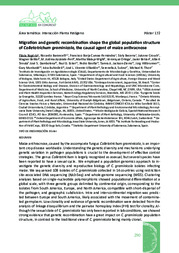Migration and genetic recombination shape the global population structure of Colletotrichum graminicola, the causal agent of maize anthracnose.
Migration and genetic recombination shape the global population structure of Colletotrichum graminicola, the causal agent of maize anthracnose.
Author(s): ROGERIO, F.; BARONCELLI, R.; CUEVAS-FERNÁNDEZ, F. B..; BECERRA. S.; CROUCH, J.; BETTIOL, W.; AZCÁRATE-PERIL, M. A.; MALAPI-WIGHT, M.; ORTEGA, V.; BETRAN, J.; TENUTA, A.; DAMBOLENA, J. S.; ESKER, P. D.; REVILLA, P.; JACKSON-ZIEMS, T. A.; HILTBRUNNER, J.; MUNKVOLD, G.; BUHINICEK, I.; VICENTE-VILLARDÓN, J. L.; SUKNO, S. A.; THON, M. R.
Summary: Maize anthracnose, caused by the ascomycete fungus Colletotrichum graminicola, is an important crop disease worldwide. Understanding the genetic diversity and mechanisms underlying genetic variation in pathogen populations is crucial to the development of effective control strategies. The genus Colletotrichum is largely recognized as asexual, but several species have been reported to have a sexual cycle. We employed a population genomics approach to investigate the genetic diversity and reproductive biology of C. graminicola isolates infecting maize. We sequenced 108 isolates of C. graminicola collected in 14 countries using restriction site-associated DNA sequencing (RAD-Seq) and whole-genome sequencing (WGS). Clustering analyses based on single-nucleotide polymorphisms showed populational differentiation at a global scale, with three genetic groups delimited by continental origin, corresponding to the isolates from South America, Europe, and North America, compatible with short-dispersal of the pathogen, and geographic subdivision. Intra and inter-continental migration was predicted between Europe and South America, likely associated with the movement of contaminated germplasm. Low clonality and evidence of genetic recombination were detected from the analysis of linkage disequilibrium and the pairwise homoplasy index (PHI) test for clonality. Although the sexual state of C. graminicola has only been reported in lab conditions, we showed strong evidence that genetic recombination have a great impact on C. graminicola population structure, in contrast to the traditional view of C. graminicola being mainly clonal.
Publication year: 2022
Types of publication: Abstract in annals or event proceedings
Unit: Embrapa Environment
Keywords: Colletotrichum Graminicola, Maize anthracnos, Milho
Observation
Some of Embrapa's publications are published as ePub files. To read them, use or download one of the following free software options to your computer or mobile device. Android: Google Play Books; IOS: iBooks; Windows and Linux: Calibre.
Access other publications
Access the Agricultural Research Database (BDPA) to consult Embrapa's full library collection and records.
Visit Embrapa Bookstore to purchase books and other publications sold by Embrapa.

